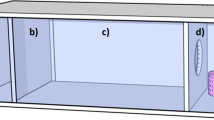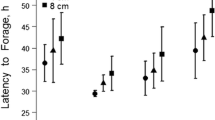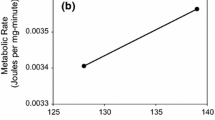Abstract
Two larval foraging strategies inDrosophila melanogaster were identified, “rover” and “sitter.” “Rovers” traverse a large area while feeding whereas “sitters” cover a small area. The difference between “rovers” and “sitters” was analyzed genetically by chromosomal substitutions between isogenic stocks. Differences in larval locomotor behavior (“crawling behavior”) can be attributed to the second chromosome, the “rover” strategy being dominant over the “sitter” strategy. Differences in feeding rate (“shoveling behavior”) are affected additively by both the second and third chromosomes. Natural populations ofDrosophila larvae were sampled three times over a 2-month period; “rovers” and “sitters” were at constant frequencies in these populations. The two foraging strategies are discussed in the light of resource utilization in environments where food is distributed continuously or discontinuously.
Similar content being viewed by others
References
Ayala, F. J. (1970). Competition, coexistence and evolution. In Hecht, M. K., and Steere, W. C. (eds.),Essays in Evolution and Genetics in Honour of Theodosius Dobzansky, Appleton-Century-Crofts, New York, pp. 121–159.
Bakker, K. (1961). An analysis of factors which determine success in competition for food among larvae ofDrosophila melanogaster.Arch. Neer. Zool. 14:200–281.
Bakker, K. (1969). Selection for rate of growth and its influence on competitive ability ofDrosophila melanogaster.Neth. J. Zool. 19:541–595.
Burnet, B., Connolly, K., and Mallinson, M. (1974). Activity and sexual behavior of neurological mutants ofDrosophila melanogaster.Behav. Genet. 4:227–235.
Burnet, B., Sewell, D., and Bos, M. (1977). Genetic analysis of larval feeding behavior inDrosophila melanogaster. II. Growth relations and competition between selected lines.Genet. Res. Camb. 30:149–161.
Connolly, K. (1966). Locomotor activity inDrosophila. II. Selection for active and inactive strains.Anim. Behav. 14:444–449.
Demerec, M. (ed.) (1950).Biology of Drosophila, Wiley, London.
Futuyama, D. J. (1970). Variation in genetic response to interspecific competition in laboratory populations ofDrosophila, Am. Nat. 104:239–252.
Gibo, D. L. (1972). A stabilizing interaction between the founder effect and interdeme mixing in competing populations ofDrosophila melanogaster andDrosophila simulans.Can. J. Zool. 50:325–331.
Godoy-Herrera, R. (1977). Inter- and intra-populational variation in digging inDrosophila melanogaster larvae.Behav. Genet. 7:433–439.
Hedrick, P. H. (1972). Factors responsible for a change in competitive ability inDrosophila.Evolution 26:513–522.
Lindsley, D. C., and Grell, E. H. (1967).Genetic Variations of Drosophila Melanogaster, Carnegie Institute of Washington Publication 627, Washington, D.C.
Miller, R. S. (1964a). Interspecies competition in laboratory populations ofDrosophila melanogaster andDrosophila simulans.Am. Nat. 98:221–238.
Miller, R. S. (1964b). Larval competition inDrosophila melanogaster, andDrosophila simulans.Ecology 45:132–148.
Muller, H. J., and Oster, I. I. (1963). Some mutational techniques inDrosophila. In Burdette, W. J. (ed.),Methodology in Basic Genetics, Holden-Day, San Francisco, pp. 249–278.
Ohnishi, S. (1979). Relationship between larval feeding behavior and viability inDrosophila melanogaster andDrosophila simulans.Behav. Genet. 9:129–134.
Parsons, P. A. (1975). The comparative evolutionary biology of the sibling species,Drosophila melanogaster andD. simulans.Q. Rev. Biol. 50:151–169.
Parsons, P. A. (1977). Genes, behavior, and evolutionary processes: The genusDrosophila.Adv. Genet. 19:1–32.
Parsons, P. A. (1978). Habitat selection and evolutionary strategies inDrosophila: An invited address,Behav. Genet. 8:511–526.
Rapport, E., and Sing, C. F. (1971). The genetic basis of a specific phenocopy response.Can. J. Genet. Cytol. 13:822–833.
Sewell, D., Burnet, B., and Connolly, K. (1975). Genetic analysis of larval feeding behavior inDrosophila melanogaster.Genet. Res. Camb. 24:163–173.
Sewell, D. F., Hunt, D. M., and Burnet, B. (1975). Biogenic amines inDrosophila melanogaster selected for differences in larval feeding behavior.Behav. Biol. 15:213–217.
Author information
Authors and Affiliations
Rights and permissions
About this article
Cite this article
Sokolowski, M.B. Foraging strategies ofDrosophila melanogaster: A chromosomal analysis. Behav Genet 10, 291–302 (1980). https://doi.org/10.1007/BF01067774
Received:
Accepted:
Issue Date:
DOI: https://doi.org/10.1007/BF01067774




